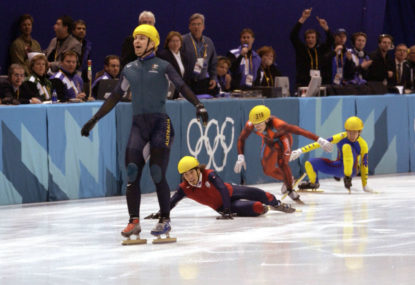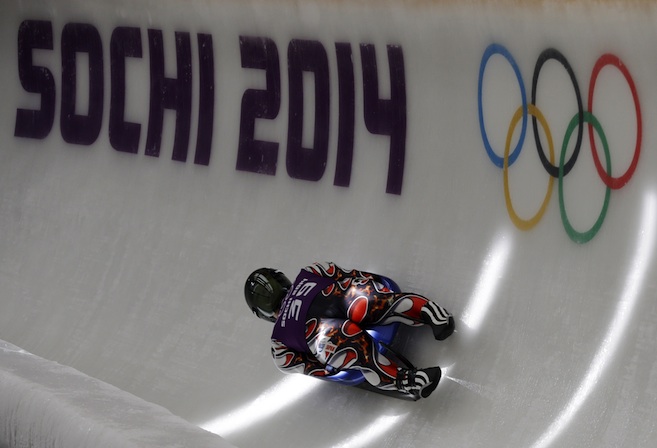'An iconic roster': LeBron, Steph, KD headline all-star cast for Team USA's shot at Olympic glory
LeBron James is going back to the Olympics for the first time in 12 years. Steph Curry is headed to the games for the…

Last week, I read this article on The Ringer which ranks each category of Winter Olympic sports according to viewing experience.
I thought, why not do the same for The Roar? I’ve rated the event categories rather than individual events, from 15-1, just to make things a bit easier. Some of the rankings I’ve come up with are the same, some are different.
The Winter Olympics sport are all (with the exception of curling) frankly, dangerous, which is bad for the competitors, but does play into the interest factor for viewers.
These are my personal views only, based on my absolutely inexpert knowledge of all winter sports. I am a terrible skier, and have never attempted any of the other sports. Nevertheless, like all of us playing along at home, after five minutes of watching a sport I like to style myself as a an expert.
So, here goes.
15. Cross-country skiing
I’m a fan of the race strategy that goes into the cross-country event, but let’s face it, it’s basically like a marathon on skis. Marathons are good in short bursts, but watching one hour of it can be a bit like watching paint dry. The team events can be more interesting, but are generally devoid of much thrill factor, which makes cross-country the least interesting Winter Olympic sport to watch.
14. Biathlon
Seeing as the majority of this sport involves cross-country skiing, it’s clearly not high on the list of interest rankings. The fact that it also involves shooting adds more interest, but not enough to make it worth watching for the casual viewer.
13. Nordic combined
Possibly one of the most bizarre events at the Olympics, it combines cross-country skiing and ski jumping. Why someone thought that combining these two events would be a recipe for success is anyone’s guess.
Obviously the ski jumping factor – where competitors literally fly through the air – makes this event more interesting than straight cross-country skiing, but again, not enough to hold the interest.
12. Luge
Luge scores high on the danger factor, but lower on the interest factor. It’s like going down a giant waterslide, only you go down an icy track on a thin sled at speeds around 100km per hour, with no brakes and only your feet for steering. It can be thrilling at times, but on the whole it’s only interesting when there are crashes (unfortunately).

(AP Photo/Natacha Pisarenko)
11. Skeleton
Gets the points over luge due to the increased danger factor. If sliding feet-first down an icy track wasn’t enough, some bright spark decided it would be even better if competitors went down head first. This is arguably the most dangerous sport at the Olympics – people have died in the past in skeleton races.
Why anyone would want to do skeleton is beyond me, but hats off to them. The best thing about skeleton are the helmets – seeing an Iron Man helmet coming straight at you from your TV view is pretty cool.
10. Ski jumping
This slots into this spot given that it’s the only sport where competitors literally fly through the air after launching from a giant tower. This is unarguably very cool. However, from an armchair perspective, it’s near impossible to tell in the air whether a jump is any good, as they pretty much all look the same.
I also find it bizarre why anyone would decide they want to specialise in ski jumping, as opposed to, you know, skiing. But apparently many people do.
9. Bobsled
For me, the team dynamic of the bobsled gets it points over the other sliding sports – yes, I know there are team luge events, but the fact that the bobsled can have up to four competitors in the same vehicle makes for interesting viewing and means there’s always more of a chance things can go wrong.
8. Freestyle skiing
I love aerial skiing, so if I was rating individual sports rather than events, it would be right near the top. However, the Slopestyle and half-pipe events bring this down a notch in my eyes.
Those are two events that work well on a snowboard, but seeing someone ski up and down a half-pipe, spinning around on skis and trying to land backwards, is just bizarre. Don’t get me wrong – the tricks are obviously very skilful and it looks extremely difficult, but for me, skis are made for skiing – that is, for going either across or down a mountain, or straight off one jump. Leave the halfpipe to the snowboarders.
7. Long-form speed skating
Long-distance speed skaters often compete against only the clock, or only one opponent, in separate lanes. This means that there are very opportunities for carnage, which can drive down the interest level. I enjoy watching this for the obvious skill, but it’s not something I’m going to stay tuned to for more than about 15 minutes.
6. Snowboarding
Like with skiing, I’m still not a massive fan of the Slopestyle competition, probably because I’ve never really watched skateboarding, but the snowboard X and half-pipe competitions have both carnage factor and are exciting enough to hold viewer interest.
I much prefer races to events scored by judges, because I feel that they are less subjective, and as a viewer, you have a much better idea of how a competitor is going than if you have to wait for an adjudicated score. The ‘relatability’ of snowboarding also makes it exciting for viewers, and possibly also makes it easier for us to appreciate the difficulty and skill of the event.

(Photo by Clive Rose/Getty Images)
5. Curling
Obviously the danger factor here is low – you don’t watch curling for the spills. It is, however, a strangely mesmerising sport, given it closely resembles lawn bowls on ice. Perhaps it’s the intimate view we get – we’re up close with the competitors, and so we can see their emotions and study the game in detail. Whatever the case, I find that I often go into a curling match prepared for it to be boring – and I’m always strangely intrigued.
After four or five ends, I’m fully into it. The thing that takes curling to another level are the outfits – it’s one of the only sports where competitors where what look like pyjamas. The Norwegian men’s team have made a name for themselves with their zany outfits – check out this year’s edition, which included love-heart patterned pants for their match on Valentine’s Day.
4. Ice hockey
It has danger value and unpredictability in spades. You never know what’s going to happen in a game, and the different strategies used by various teams can be fascinating. The fact that viewers are familiar with NHL players in particular often makes this more entertaining than sports in which we have no idea who the competitors are.

(midwinter / Flickr)
3. Figure skating
Or dancing on ice, either way. Yes, it’s more sedate than some of the other sports on this list, but the dual requirement for grace and technicality have it ranked in this spot. Interest is also garnered through the many different formats and types of skating.
It’s also pretty much the only Winter Olympic sport in which viewers get the chance to critique outfits, aesthetics and song choices. One pair in last week’s competition danced their routine to the Star Wars theme song, which was certainly well received in the stadium.
2. Alpine skiing
Arguably the most thrilling sport of the Winter Olympics. The majority of us can relate to skiing, although not like this. These crazy competitors ski down icy tracks at a million miles an hour, often having to navigate tight turns, gate placements that change after each run, and a course that drops sharply downhill.
I watch these races with a mixture of awe and anxiety, such is the frequency with which competitors crash and are injured.
1. Short-track speed skating
This just gets the nod over alpine skiing as the best Winter Olympic sport. This is the category in which Steven Bradbury famously won gold in Salt Lake City in 2002. Crashes happen aplenty, and rather than just racing the clock, competitors race each other on a track with tight turns. It’s thrilling to watch and has the ability to hold your attention the whole way through.